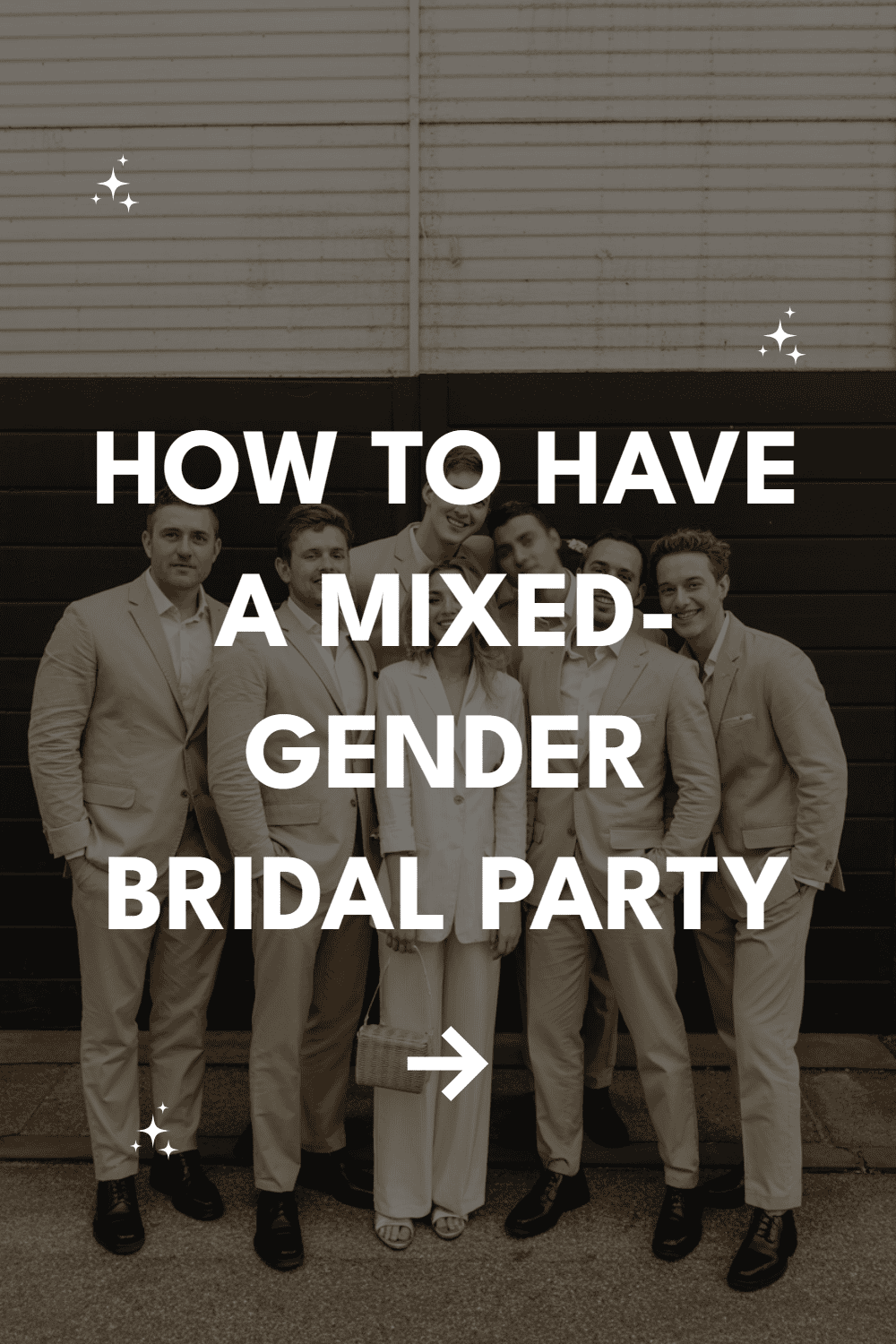Gone are the days when wedding parties had to look like they were separated by an invisible gender line down the aisle.
Modern couples are breaking tradition and choosing their closest friends and family members regardless of gender—and honestly, it’s about time.
The key to pulling off a mixed-gender bridal party isn’t complicated, but it does require some thoughtful planning and clear communication with your wedding party.
Breaking Down the Traditional Structure
Traditional wedding parties operate on a pretty rigid system: bridesmaids stand with the bride, groomsmen with the groom, and everyone wears coordinating outfits based on their assigned side.
But what happens when your best friend since childhood is a guy, or your partner’s closest confidant is their sister?
You throw the rulebook out the window and create something that actually reflects your relationships.
The people standing beside you on your wedding day should be there because they matter to you, not because they happen to have the “right” anatomy for their designated side.
Deciding Who Goes Where
The biggest question couples face is whether to mix genders on both sides or keep some traditional elements. There’s no wrong answer here—it’s entirely about what feels right for your relationships and your vision.
Some couples choose to have each person stand on the side of whoever they’re closest to, regardless of gender. Others prefer to alternate or create a completely mixed lineup on both sides.
Consider these common arrangements:
• Relationship-based: Each person stands with whoever invited them
• Aesthetic mixing: Alternate genders for visual balance
• Completely integrated: Mix everyone together regardless of traditional sides
• Hybrid style: Some traditional elements with strategic gender mixing
Addressing the Outfit Dilemma
Clothing coordination becomes more interesting when you’re working with multiple genders, but it’s far from impossible. The secret lies in finding common elements that work across different types of formal wear.
Color becomes your best friend in this situation. Choose a palette that translates well to both dresses and suits, then let your wedding party interpret it within their assigned garment type.
Creating Cohesion Across Different Garments
Start with your primary wedding colors and think about how they’ll look in various fabrics and styles. Jewel tones, earth tones, and classic colors like navy or burgundy tend to work beautifully across both dresses and suits.
Consider texture and formality level as unifying elements. If your female-identifying attendants are wearing satin, look for suits with subtle sheen or texture that echoes that richness without being matchy-matchy.
Practical Outfit Guidelines
Give your wedding party clear guidelines about formality level, color palette, and any specific requirements. Be more specific than “wear something blue”—provide actual color swatches or specific shade names.
Think about accessories as another way to tie everyone together. Matching boutonnieres, corsages, or even simple ribbon details can create visual unity across different outfit styles.
Handling the Processional Logistics
Walking down the aisle with a mixed-gender party requires some choreography planning, but it’s nothing your wedding coordinator (or you) can’t handle. The key is deciding early so everyone knows what to expect.
Traditional processionals have bridesmaids and groomsmen entering separately, but mixed parties offer more creative options. You might have everyone walk in pairs, regardless of gender, or have each person walk solo for a more individualized entrance.
Pairing Strategies That Actually Work
If you’re going with paired entrances, think about personality matches rather than just height compatibility. That confident friend who loves attention pairs beautifully with someone who’s happy to share the spotlight.
Height differences matter less than you think they will in photos, and mismatched heights can actually create visual interest. Focus on creating pairs who’ll feel comfortable walking together and look natural side by side.
Alternative Processional Ideas
Consider having your entire wedding party enter together as one group, creating a supportive cluster around you and your partner. This works especially well for smaller wedding parties or more casual ceremonies.
Some couples choose to have their wedding party already positioned at the altar when guests arrive, eliminating the processional question entirely while creating a powerful visual impact.
Managing Expectations and Questions
Family members and traditional guests might have questions or concerns about your mixed-gender wedding party. Prepare yourself with confident, brief explanations that shut down potential drama before it starts.
The phrase “We chose the people who mean the most to us” tends to end most conversations quickly and positively. Most people understand the sentiment, even if the execution looks different from what they expected.
Dealing with Vendor Confusion
Some vendors, particularly photographers and coordinators, might need extra clarification about your setup. Be explicit in your communications and provide a clear list of who’s in your wedding party and how you want them positioned.
Create a simple diagram showing your preferred ceremony layout and share it with anyone who needs to understand the logistics. Visual aids prevent day-of confusion and ensure everyone’s on the same page.
Pre-Wedding Event Considerations
Bachelor and bachelorette parties become more fluid when your wedding party spans multiple genders. Some couples choose to have joint celebrations, while others stick with separate events but include cross-gender friends.
The key is asking your wedding party what they’re comfortable with and planning accordingly. Some people love the idea of joint celebrations, while others prefer more traditional separate events.
Planning Inclusive Celebrations
Joint celebrations work best when you focus on activities everyone can enjoy together. Consider group trips, dinner parties, or adventure activities that don’t rely on gender-specific traditions.
If you’re sticking with separate events, think about which friends would be most comfortable in which setting. Your male friend might prefer the bachelorette party activities, and that’s perfectly fine.
Photography and Positioning
Wedding photographers are increasingly experienced with mixed-gender parties, but it’s worth discussing your vision during your planning meetings. Share inspiration photos that show the kind of group shots you’re hoping to achieve.
Positioning becomes more about creating visual balance and highlighting relationships than following traditional gender-based rules. Your photographer can help arrange everyone in ways that look natural and beautiful.
Getting the Shots You Want
Think about which combinations of people you definitely want photographed together, beyond just the standard “all bridesmaids” or “all groomsmen” shots. Mixed parties offer opportunities for more meaningful grouping combinations.
Consider individual photos with each wedding party member, regardless of which “side” they’re technically on. These images often become treasured keepsakes that better reflect your actual relationships.
Day-Of Logistics and Coordination
Getting ready on the morning of your wedding might require some creative space planning when your wedding party includes multiple genders.
Some couples choose to get ready separately regardless of wedding party composition, while others embrace the chaos of everyone together.
Think practically about privacy needs, space constraints, and comfort levels. Not everyone will be comfortable changing clothes or doing hair and makeup in mixed company, and that’s completely valid.
Creating Comfortable Spaces
Consider renting additional getting-ready spaces or timing the preparations so different groups can use the same space sequentially. The goal is ensuring everyone feels comfortable and included without forcing anyone into uncomfortable situations.
Designate specific times for group photos during getting-ready coverage, when everyone’s dressed and ready to be photographed together. This ensures you get those candid preparation shots without compromising anyone’s privacy.
Reception Considerations
The reception offers more flexibility for mixed-gender wedding parties, but you’ll still need to think through a few logistics. Head table arrangements, introductions, and speeches might need slight adjustments from traditional formats.
Consider whether you want your wedding party seated together at a head table, scattered throughout the reception, or arranged in some other configuration that makes sense for your group dynamics.
Making Everyone Feel Included
Plan wedding party introductions that highlight each person’s relationship to you rather than their traditional wedding party role. Instead of “bridesmaids and groomsmen,” introduce them as “our chosen family” or “the people who got us here.”
Think about speech opportunities beyond the traditional best man and maid of honor roles. Mixed parties often mean multiple people who might want to speak, and that’s a beautiful thing to celebrate.
Embracing the Beautiful Chaos
Mixed-gender wedding parties reflect the reality of modern friendships and chosen family structures. They’re messier than traditional arrangements, sure, but they’re also more authentic to how most people actually live their lives.
Your wedding day should celebrate the relationships that matter most to you, regardless of whether they fit into neat traditional categories.
The people who’ve supported your relationship and will continue supporting your marriage deserve to stand beside you, period.
The most important thing to remember is that your wedding party exists to support and celebrate you.
When you choose people based on love and relationship rather than gender and tradition, you’re creating a foundation of authentic support that will serve you well beyond your wedding day.


